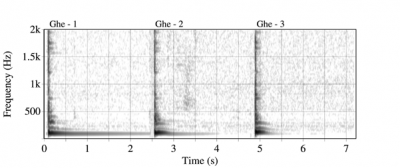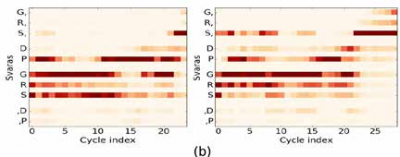

While digital tuners are commonly used by musicians to set precisely tuned pitches in an instrument, instrument beginners can benefit greatly from an automatic device that measures the overall ‘goodness’ of the sound in order to provide corrective feedback on the articulation skill of the player. Intonation, dynamics and tone quality are important attributes of musical sounds that can be estimated by acoustic signal analyses.
Our research is directed towards Indian instruments including the tabla which has a sophisticated palette of basic sounds, each characterised by a distinct vocalised syllable known as a bol. Detection of the correctness of a player’s gesture is possible, in terms of the manner of striking, hand pressure and the location on the surface which is struck,via the learning from data of the correlations between acoustic signal characteristics and human expert ratings. The figures below show an example of the tabla stroke Ghe in which the rates of decay after stroke onset of the different spectral components clearly discriminate a good stroke from wrongly played strokes. A concurrent research project involves the sounds of the sitar and how these are affected by the filing of the curved bridge (jawari) which contributes to the richness of its timbre. The studies are expected to lead to digital tools for automatic feedback potentially useful to musicians, learners and instrument makers.
Audio signal analyses are also applied to recordings of entire music performances to obtain insights on the relationship of music theory with practice. In the rich improvisational traditions of Indian classical music, analyses of great performances can reveal, for instance, how musical creativity aligns with the mandated raga grammar.
In the figures above, we show how performances of a chosen raga by the same vocal artist on two separate occasions closely match in the overall distribution of melodic material in accordance with the raga grammar but display very different characteristics in its gradual unfolding over time. The analysis tools can be valuable in musicology research and in music pedagogy.
Prof. P S Rao
